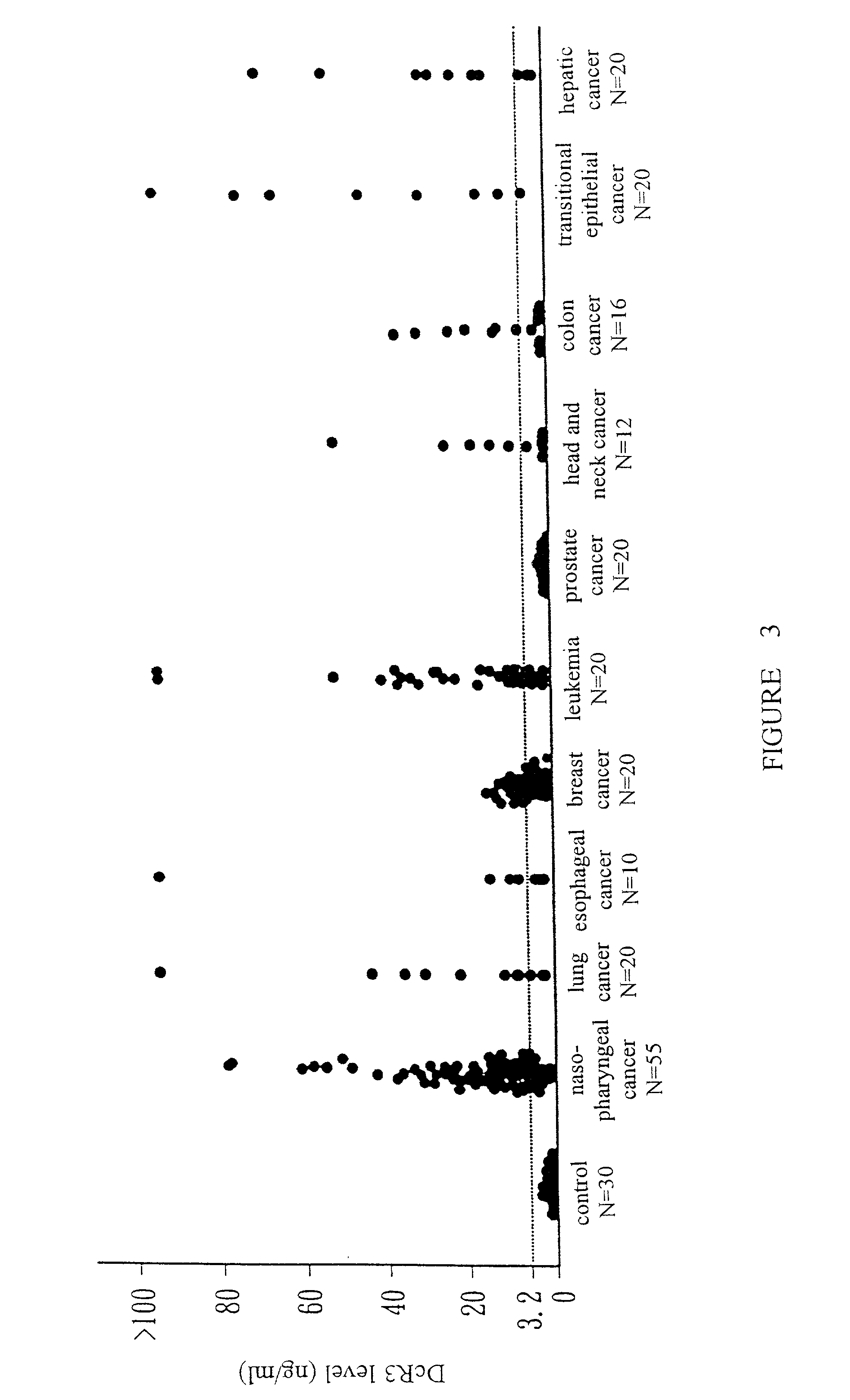Monoclonal antibodies for the detection of decoy receptor 3, hybridomas producing said antibodies and uses thereof
a hybridoma and antibody technology, applied in the field of monoclonal antibodies for the detection of decoy receptor 3, can solve the problems of not being able to disclose the clinical diagnosis method applicable to diseases, not being able to express dcr3 specifically in the serum, and not being able to achieve the specificity of antibodies,
- Summary
- Abstract
- Description
- Claims
- Application Information
AI Technical Summary
Problems solved by technology
Method used
Image
Examples
example 1
[0027] Preparation of DcR3-Fc Fusion Protein
[0028] (A) Based on the EST cDNA library, cDNA fragment of human DcR3 was amplified with PCR from the human embryo lung cDNA library. The fragment was then cloned to be linked with the Fc portion of human G1 immunoglobulin (IgG1 Fc).
[0029] (B) Cell Transfection to Introduce Expression Vectors
[0030] In a 35-mm dish, moth larva cell line Sf21 was prepared and cultured overnight. In a polystyrene tube, about 100-200 ng DNA of Autographa california multiple nuclear polyhedrosis virus (AcMNPV, Clontech Co.) which was made linear by enzyme digestion and about 500-1000 ng DNA of a transfer vector comprising human DcR3 gene were mixed. Equal volume of a 1.5.times. dilution of Lipofectin (Gibco Co.) was added and mixed. The mixture was incubated at room temperature for 15 minutes. The moth larva cell line Sf21 cultured overnight was washed twice with 2 ml culture medium without fetal calf serum (FCS), care being taken to maintain the cell monolayer...
example 2
[0043] Preparation of Hybridoma Producing Human DcR3 Monoclonal Antibody
[0044] 50 .mu.g fusion protein (Example 1) in a total volume of 0.2 ml was injected subcutaneously to the abdomen or back of mouse (Balb / c) periodically every three weeks. After four times of immunization, mouse was sacrificed by cervical vertebra dislocation. Spleen cells were isolated and fused with 3-5 folds of myeloma NS-1 cells. Said spleen cells were washed down by 10 ml culture broth (RPMI-1640.RTM.) without FCS and left standing in a 50-ml centrifuge tube. Given amounts of myeloma NS-1 cells were measured separately, washed twice with 10 ml RPMI-1640.RTM., and centrifuged at 300.times.g for 5 minutes at room temperature. After the third and fourth washing, spleen cells contained in the upper layer of culture broth after the standing treatment were added (without the other tissues contained in the lower layer). The cells were washed together and then centrifuged at 500.times.g for 5 minutes at room temper...
example 3
[0046] Selection of Hybridoma Producing Human DcR3 Monoclonal Antibody
[0047] 100 .mu.l per well of purified protein at 0.5 .mu.g / ml concentration was diluted with coating buffer and then immobilized in a 96-well culture plate (Costar Co.). After reacting at 4.degree. C. for 16 hours, the wells were treated with phosphate-buffered saline containing 0.05% Tween-20 (PBST). After washing once with 300 .mu.l per well, 200 .mu.l blocking buffer was added. The reaction was carried out at room temperature for 1 hour and then washed with PBST for three times. Culture broth pre-cultivated with cell hybridoma was added. The reaction was carried out at room temperature for 2 hours and then washed with PBST for five times. A 2,000-fold dilution (PBST) of goat anti-mouse immunoglobulin G linked with horseradish peroxidase (Zymed Co.) was added. The reaction was carried out at room temperature for 1 hours and then washed with PBST for five times. 100 .mu.l enzyme substrate visualization solution (...
PUM
| Property | Measurement | Unit |
|---|---|---|
| total volume | aaaaa | aaaaa |
| volumes | aaaaa | aaaaa |
| total volume | aaaaa | aaaaa |
Abstract
Description
Claims
Application Information
 Login to View More
Login to View More - Generate Ideas
- Intellectual Property
- Life Sciences
- Materials
- Tech Scout
- Unparalleled Data Quality
- Higher Quality Content
- 60% Fewer Hallucinations
Browse by: Latest US Patents, China's latest patents, Technical Efficacy Thesaurus, Application Domain, Technology Topic, Popular Technical Reports.
© 2025 PatSnap. All rights reserved.Legal|Privacy policy|Modern Slavery Act Transparency Statement|Sitemap|About US| Contact US: help@patsnap.com



